#Auschwitz-Birkenau concentration camp
Text
"We Remember "Live stream from Auschwitz-Birkenau concentration camp.
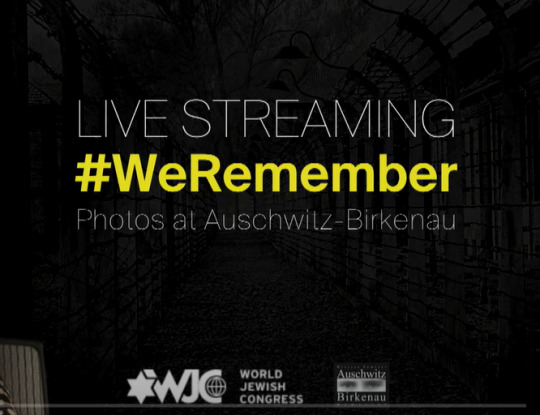
Follow as your photos of remembrance for International Holocaust Remembrance Day are projected at the former Auschwitz-Birkenau concentration camp where 1.1 million people were murdered. #WeRemember
youtube
#Auschwitz-Birkenau concentration camp#honor the victims#27 january#weremember#photo exhibition#world jewish congress#wjc#international day of commemoration in memory of the victims of the holocaust#Youtube
1 note
·
View note
Text
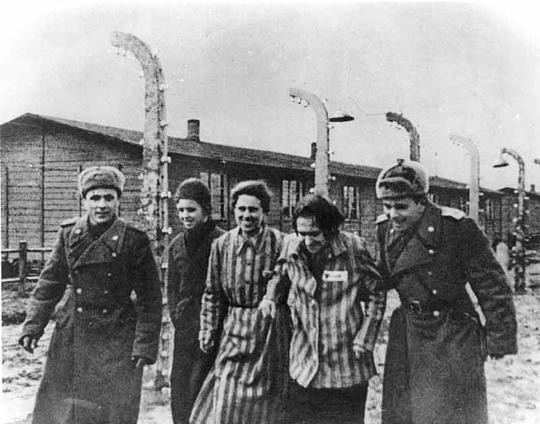
The 60th Army of the 1st Ukrainian Front liberating the Auschwitz-Birkenau concentration camp in early 1945.
#holocaust#ukrainian history#ukraine#world war 2#antisemitism#ukrainian armed forces#world war ii#concentration camp#20th century#1945#1940s#jewish history#auschwitz#birkenau#black and white#old photo#eastern europe
30 notes
·
View notes
Text
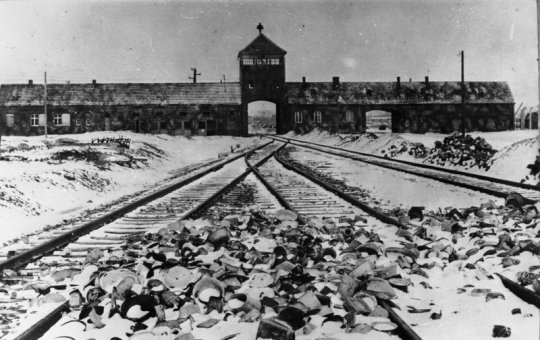
Auschwitz, Poland
Soldiers of the 100th Infantry Division of the Red Army entered the camp around 9 am on Saturday, 27 January 1945.
Roughly 7,000 prisoners are found alive.
In the time from 1940 to 1945 an estimated 1,080,000–1,085,000 were killed within its walls.
79 years since the liberation.
35 years since I first learned of it in school.
35 years since I first saw pictures of the dead.
35 years since I learned in detail what humans are capable of doing to other human beings.
79 years and facism becomes more and more fasionable again all around the world.
I'm in my core an optimist, but on days like today I'm scared shitless due to the fact, that history has the habit to repeat itself.
Humans have the habit to forget.
I dont't.
„Ihr seid nicht schuld an dem, was war, aber verantwortlich dafür, dass es nicht mehr geschieht. “
"You are not responsible for what happened. But you are responsible for it not happening again."
(Max Mannheimer 1920-2016, Holocaust survivor)
#never again#holocaust#shoah#auschwitz#auschwitz birkenau#concentration camp#never forget#fck nazis#fck racism
9 notes
·
View notes
Text

Les portes du camp de concentration d'Auschwitz-Birkenau vues de l'intérieur du camp – Oswiecim – Pologne – Après le 27 janvier 1945
©Auschwitz-Birkenau Museum
#WWII#camps de concentration#concentration camps#auschwitz-birkenau#auschwitz#nazisme#nazism#holocauste#holocaust#shoah#génocide#genocide#oswiecim#pologne#poland#1945
11 notes
·
View notes
Text
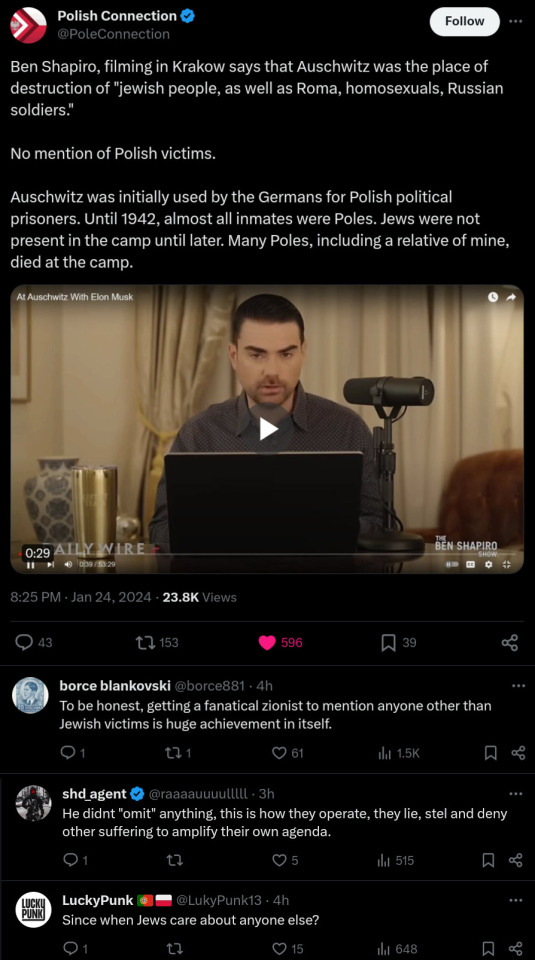
Meanwhile in American zionist clownland….
Ben Shapiro is a smooth-brained conservative pundit who sounds like Kermit the Frog and has spent his entire life trying to achieve peak stupidity. He's also a fanatical zionist, and justifies his unquestioning support for Israel with profound statements like: "Settlements rock! Israelis like to build - Arabs like to bomb crap and live in open sewage"….
In January 2024, after a high profile visit to the Auschwitz Memorial Museum with Elon Musk, he posted a video in which he said that Jews, Roma, Russian soldiers and homosexuals were killed there, but failed to mention the Polish victims.
Although Auschwitz-Birkenau eventually became an extermination centre in which nearly a million Jews were murdered, the Germans created the camp in 1940 initially for the purpose of interning Polish slavic prisoners, who made up the majority of the inmates until 1942.
According to the Auschwitz Memorial Museum, at least 1.1 million of the 1.3 million people who were deported to Auschwitz-Birkenau died there.
900,000 Jews were murdered in the gas chambers immediately on arrival at the camp.
Of the 400,000 people who were registered as inmates, more than 50% did not survive.
They included 100,000 Jews, 70,000 Polish slavs, 21,000 Roma, 14,000 Soviet POWs and more than 10,000 prisoners of other nationalities, who died as a result of executions, medical experiments, starvation, brutality and disease.
Nobody knows how many LGBT people were deported to Auschwitz or died there, but only a tiny number were sent to the camp specifically for being gay. It's known that at least 77 men with pink triangles were imprisoned in Auschwitz and some scholars speak of up to 140 prisoners persecuted for their sexual orientation.
During their visit, Musk and Shapiro laid a wreath at the reconstructed "wall of death" next to Block 11, where SS men shot several thousand people, nearly all of whom were ethnically Polish - both Auschwitz prisoners and people who had been sent to the camp specifically to be executed, mainly for resistance activities.
It's amazing how often the camp's second largest victim group get erased from Western historical memory, but at least Shapiro didn't refer to Auschwitz as a "Polish concentration camp"….
#ben shapiro#american idiot#elon musk#history#auschwitz#auschwitz-birkenau#concentration camp#german concentration camp#second world war#world war 2#germany#poland#polska#israel#palestine#historical revisionism#bad history takes#bad history take
4 notes
·
View notes
Text
Photographing Auschwitz-Birkenau
It was one of the most surreal and emotional parts of my journey around Europe. But it had to be done.
In the UK, most children visit Auschwitz as part of a school trip when learning about the Holocaust in History lessons. I missed out when I was in school, and missed out again as a teacher because of the pandemic. I’m a firm believer that everyone should experience this once in their life, it…

View On WordPress
3 notes
·
View notes
Text
Holocaust Memorial Museum: How Many People Did the Nazis Murder?
Nazi Germany committed mass murder on an unprecedented scale. Before and especially during World War II, the Nazi German regime perpetrated the Holocaust and other mass atrocities. In the aftermath of these crimes, calculating the number of victims became important for legal, historical, ethical, and educational reasons.
The statistics below were calculated using a number of different sources.…

View On WordPress
#Auschwitz#Birkenau#Concentration camps#genocide#holocaust#Holocaust Memorial Museum How Many People Did the Nazis Murder?#How Many People Did the Nazis Murder?#israel#Jews#Nazi#Nazi Germany#WWII
0 notes
Text

Nazis attempted to cover up their crimes in the Holocaust—and denial of the genocide persists to this day. Scholars say memorials—like this one in the former train station of Pithiviers, France, from which Jews were sent to death camps—are essential to fighting anti-Semitism. Photograph By Christophe Pitit Tesson, Pool/AFP Via Getty Images
How The Holocaust Happened In Plain Sight
Six Million Jews were Murdered Between 1933 and 1945. How Adolf Hitler and the Nazi Party Turned Anti-Semitism into Genocide.
— By Erin Blakemore | Published: January 27, 2023
Six million Jews murdered. Millions more stripped of their livelihoods, their communities, their families, even their names. The horrors of the Holocaust are often expressed in numbers that convey the magnitude of Nazi Germany’s attempt to annihilate Europe’s Jews.
The Nazis and their collaborators killed millions of people whom they perceived as inferior—including Jehovah’s Witnesses, gay men, people with disabilities, Slavic and Roma people, and Communists. However, historians use the term “Holocaust”—also called the Shoah, or “disaster” in Hebrew—to apply strictly to European Jews murdered by the Nazis between 1933 and 1945.
No single statistic can capture the true terror of the systematic killing of a group of human beings—and given its enormity and brutality, the Holocaust is difficult to understand. How did a democratically elected politician incite an entire nation to genocide? Why did people allow it to happen in plain sight? And why do some still deny it ever happened?

A shop selling household goods and clocks on Pinkas Street in the Jewish Quarter of Prague, then part of Czechoslovakia. In many parts of Eastern Europe, anti-Semitism was rampant before the Holocaust and Jews were forced to live separately from the rest of the population. Photograph Via History & Art Images, Getty Images

After Germany invaded Poland in 1939, Polish Jews were forced into ghettos like this one in Warsaw. This image taken by an unknown German photographer was later exhibited at the war crime trials that sought to hold the Nazis and their collaborators accountable after the war. Photograph Via Bettmann, Getty Images
European Jews Before The Holocaust
By 1933, about nine million Jews lived across the continent and in every European nation. Some countries guaranteed Jews equality under the law, which enabled them to become part of the dominant culture. Others, especially in Eastern Europe, kept Jewish life strictly separate.
Jewish life was flourishing, yet Europe’s Jews also faced a long legacy of discrimination and scapegoating. Pogroms—violent riots in which Christians terrorized Jews—were common throughout Eastern Europe. Christians blamed Jews for the death of Jesus, fomented myths of a shadowy cabal that controlled world finances and politics, and claimed Jews brought disease and crime to their communities.
The Rise of Adolf Hitler
It would take one man, Adolf Hitler, to turn centuries of casual anti-Semitism into genocide. Hitler rose to power as leader of the National Socialist German Workers’ Party, also known as the Nazi Party, in the 1920s.
Hitler harnessed a tide of discontent and unrest in Germany, which was slowly rebuilding after losing the First World War. The nation had collapsed politically and economically, and owed heavy sanctions under the Treaty of Versailles. The Nazi party blamed Jews for Germany’s troubles and promised to restore the nation to its former glory.
Hitler was democratically elected to the German parliament in 1933, where he was soon appointed as chancellor, the nation’s second-highest position. Less than a year later, Germany’s president died, and Hitler seized absolute control of the country.

Born in Braunau am Inn, Austria, in 1889, Adolf Hitler was a skilled speaker and rose to power in Germany democratically. In the wake of its WWI loss, he blamed the country's economic woes on Jewish people and promised to restore Germany to glory. Photograph By Roger Viollet, Getty Images
The Early Nazi Regime
Immediately after coming to power, the Nazis promulgated a variety of laws aimed at excluding Jews from German life—defining Judaism in racial rather than religious terms. Beginning with an act barring Jews from civil service, they culminated in laws forbidding Jews from German citizenship and intermarriage with non-Jews.
These were not just domestic affairs: Hitler wanted to expand his regime and, in 1939, Germany invaded Poland. It marked the beginning of the Second World War—and the expansion of the Nazis’ anti-Jewish policies.
German officials swiftly forced hundreds of thousands of Polish Jews into crowded ghettoes, and with the help of locals and the German military, specially trained forces called the Einsatzgruppen began systematically shooting Jews and other people the regime deemed undesirable. In just nine months, these mobile murder units shot more than half a million people in a “Holocaust by bullets” that would continue throughout the war.
But Hitler and his Nazi officials were not content with discriminatory laws or mass shootings. By 1942, they agreed to pursue a “final solution” to the existence of European Jews: They would send the continent’s remaining Jews east to death camps where they would be forced into labor and ultimately killed.

Hitler dismisses U.S. President Franklin D. Roosevelt's appeal for peace in a speech before the Reichstag, Nazi Germany's parliament, on April 28, 1939. Months later, Germany invaded Poland. Photograph Via Universal History Archive, Universal Images Groyp/Getty Images
Genocide in Plain Sight
By characterizing their actions as the “evacuation” of Jews from territories that rightfully belonged to non-Jewish Germans, the Nazi operation took place in plain sight. Though thousands of non-Jews rescued, hid, or otherwise helped those targeted by the Holocaust, many others stood by indifferently or collaborated with the Nazis.
With the help of local officials and sympathetic civilians, the Nazis rounded up Jews, stripped them of their personal possessions, and imprisoned them in more than 44,000 concentration camps and other incarceration sites across Europe. Non-Jews were encouraged to betray their Jewish neighbors and move into the homes and businesses they left behind.
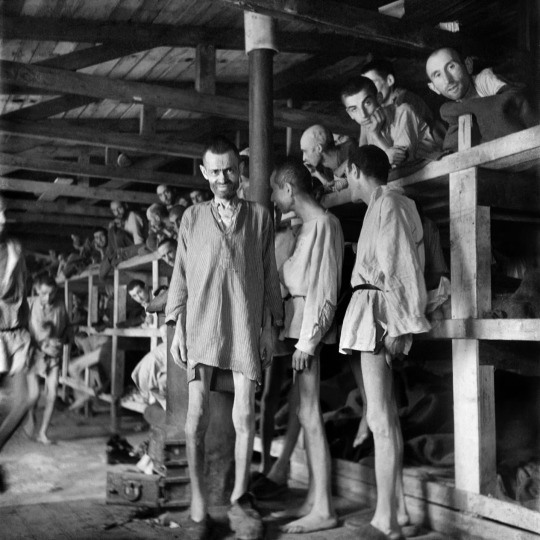
Prisoners at Buchenwald Concentration Camp, near Weimar, Germany, in April 1945, the year it was liberated. In the eight years Buchenwald was in operation, it housed between 239,000 and 250,000 prisoners, who were subjected to medical experiments and grueling forced labor. Photograph By Eric Schwab, AFP/Getty Images
Dachau, which opened near Munich in 1933, was the first concentration camp. Five others—Auschwitz-Birkenau, Chelmno, Belzec, Sobibor, and Treblinka—were designated as killing centers, where most Jews were immediately murdered upon arrival.
The killings took place in assembly-line fashion: Mass transports of Jews were unloaded from train cars and “selected” into groups based on sex, age, and perceived fitness. Those selected for murder were taken to holding areas where they were told to set aside their possessions and undress for “disinfection” or showers.
In reality, they were herded into specially designed killing chambers into which officials pumped lethal carbon monoxide gas or a hydrogen cyanide pesticide called Zyklon B that poisoned its victims within minutes.
The earliest Holocaust victims were buried in mass graves. Later, in a bid to keep the killings a secret, corpses were burned in large crematoria. Some Jews were forced to participate in the killings, and then were themselves executed to maintain secrecy. The victims’ clothing, tooth fillings, possessions, and even hair was stolen by the Nazis.

As Allied troops advanced near the end of the war, Germany sent prisoners on death marches from the western front to Dachau, near Munich. When the camp was liberated in April 1945, pictured here, U.S. troops encountered piles of dead bodies and survivors on the brink of death. Photograph By Roger Viollet, Getty Images
Life in the Camps
Those not chosen for death were ritually humiliated and forced to live in squalid conditions. Many were tattooed with identification numbers and shorn of their hair. Starvation, overcrowding, overwork, and a lack of sanitation led to rampant disease and mass death in these facilities. Torture tactics and brutal medical experiments made the camps a horror beyond description.
“It is not possible to sink lower than this; no human condition is more miserable than this, nor could it conceivably be so,” wrote Auschwitz survivor Primo Levi in his 1947 memoir. “Nothing belongs to us any more…if we speak, they will not listen to us, and if they listen, they will not understand. They will even take away our name.”
But despite almost inconceivable hardships, some managed to resist. “Our aim was to defy Hitler, to do everything we [could] to live,” recalled Majdanek and Auschwitz survivor Helen K. in a 1985 oral history. “He [wanted] us to die, and we didn’t want to oblige him.”
Jews resisted the Holocaust in a variety of ways, from going into hiding to sabotaging camp operations or participating in armed uprisings in ghettoes and concentration camps. Other forms of resistance were quieter, like stealing food, conducting forbidden religious services, or simply attempting to maintain a sense of dignity.

In 2005, the Memorial to the Murdered Jews of Europe, also known as the Holocaust Memorial, opened in Berlin, Germany. Below ground, an information center shares stories of the Holocaust's victims—which scholars say is essential to preventing history from repeating itself. Photograph By Gerd Ludwig, National Geographic Image Collection
The Aftermath of the Holocaust
As World War II drew to a close in 1944 and 1945, the Nazis attempted to cover up their crimes, burning documents, dismantling death camp sites, and forcing their remaining prisoners on brutal death marches to escape the advancing Allies.
They didn’t succeed: As they liberated swaths of Europe, Allied troops entered camps piled high with corpses and filled, in some cases, with starving, sick victims. The evidence collected in these camps would become the basis of the Nuremberg Trials, the first-ever international war crimes tribunal.l
In the war’s aftermath, the toll of the Holocaust slowly became clear. Just one out of every three European Jews survived, and though estimates vary, historians believe at least six million Jews were murdered. Among them were an estimated 1.3 million massacred by the Einsatzgruppen; approximately a million were murdered at Auschwitz-Birkenau alone.
Many survivors had nowhere to go. Poland had Europe’s largest Jewish population before the war, but lost 93 percent of that population in just five years. Entire villages and communities were wiped out and families scattered across Europe. Labeled “displaced persons,” survivors attempted to rebuild their lives. Many left Europe for good, emigrating to Israel, the United States, or elsewhere.

Top: Photographs of a man held captive at Auschwitz, the largest of the Nazi concentration camps established during the Holocaust. These images can be found inside the Menorah Jewish Center in Dnipro, Ukraine, which explores the past, present, and future of Jewish life. Photograph By Abbas, Magnum
Bottom: Six million European Jews were killed—and hundreds of thousands displaced—during the Holocaust. When the international community learned the extent of Nazi brutality during World War II, it became clear existing laws of war were inadequate for addressing these crimes. Photograph Via Bar Am Collection, Magnum Photos (Left) And Photograph Via Bar Am Collection, Magnum Photos (Right)
Holocaust Denial
Despite the enormity of evidence, some people sowed misinformation about the Holocaust, while others denied it happened at all. Holocaust denial persists to this day, even though it is considered a form of antisemitism and is banned in a variety of countries.
How to counter the hate? “Educating about the history of the genocide of the Jewish people and other Nazi crimes offers a robust defence against denial and distortion,” concluded the authors a of a 2021 United Nations report on Holocaust denial.
Though the number of Holocaust survivors has dwindled, their testimonies offer crucial evidence of the Holocaust’s horrors.
“The voices of the victims—their lack of understanding, their despair, their powerful eloquence or their helpless clumsiness—these can shake our well-protected representation of events,” said Saul Friedländer, a historian who survived the Holocaust and whose parents were murdered at Auschwitz, in a 2007 interview with Dissent Magazine. “They can stop us in our tracks. They can restore our initial sense of disbelief, before knowledge rushes in to smother it.”
#Holocaust#Six Million Jews | Murdered#Adolf Hitler#Germany 🇩🇪#Pinkas Street | Jewish Quarter | Prague | Czechoslovakia#Poland 🇵🇱 | Polish Jews | Ghettos | Warsaw#European 🇪🇺 Jews#Braunau am Inn | Austria 🇦🇹 | 1889 | Adolf Hitler#Nazi Regime#Genocide#Buchenwald Concentration Camp | Weimar | Germany 🇩🇪#Concentration Camps: Dachau | Auschwitz-Birkenau | Chelmno | Belzec | Sobibor | Treblinka#Holocaust Denial#Aftermath
0 notes
Text
I won’t get into any political argument about it, but I just watched Ricky’s last special on Netflix (Armageddon) and I obviously had to look it up:

“52 potentially trigger events”
Jesus Christ, is this even serious? It’s a film about the Shoah, one of the worst tragedies of human history and the end of western culture/civilisation as we knew it, and I really hope that there’s no one out there who wouldn’t watch it because of this stuff
Mention of honour because it’s funny:

#and u know what?#all that bit made me feel better#and u know why?#because i’m going to the fucking auschwitz-birkenau ex concentration camp#and i wrote a master thesis on the fucking thing#and i’m afraid i’ll have a panic attack or smth similar#so i was hoping ricky’s going to make a joke abt it#ricky gervais#armageddon#schindler's list#steven spielberg#shoah#holocaust#jews#nazism#nazist#jewish history#auschwitz#history#netflix#mailmiocuoredipietratremaancora
1 note
·
View note
Text
Children's Play in the Holocaust
Even in the extermination camps, the children who were still healthy enough to move around played. In one camp they played a game called "tickling the corpse." At Auschwitz-Birkenau they dared one another to touch the electric fence. They played "gas chamber," a game in which they threw rocks into a pit and screamed the sounds of people dying. One game of their own devising was modeled after the camp's daily roll call and was called klepsi-klepsi, a common term for stealing. One playmate was blindfolded; then one of the others would step forward and hit him hard on the face; and then, with the blindfold removed, the one who had been hit had to guess, from facial expressions or other evidence, who had hit him. To survive at Auschwitz, one had to be an expert at bluffing - for example, about stealing bread or about knowing of someone's escape or resistance plans. Klepsi-klepsi may have been practice for that skill.
In play, whether it is the idyllic play we most like to envision or the play described by Eisen*, children bring the realities of their world into a fictional context, where is it safe to confront them, to experience them, and to practice ways of dealing with them. Some people fear that violent play creates violent adults, but in reality the opposite is true. Violence in the adult world leads children, quite properly, to play at violence. How else can they prepare themselves emotionally, intellectually, and physically for reality? It is wrong to think that somehow we can reform the world for the future by controlling children's play and controlling what they learn. If we want to reform the world, we have to reform the world; children will follow suit. The children must, and will, prepare themselves for the real world to which they must adapt to survive.
* In the remarkable book Children and Play in the Holocaust, historian George Eisen, using diaries and interviews of survivors as evidence, described play among Jewish children in Nazi ghettos and concentration camps.
Free to Learn by Peter Gray
Chapter 8: The role of play in social and emotional development
#children#holocaust#children and the holocaust#children in the holocaust#Eisen#George Eisen#children and play in the holocaust#children and play#play#Free to Learn#Peter Gray#Gray#psychology#child psychology#concentration camp#auschwitz#Auschwitz-Birkenau#Exerpt
1 note
·
View note
Text
Regina Jonas-First female Rabbi, murdered in Auschwitz.
People sometimes ask me if I am Jewish, and they are surprised when I say I am not. There are even a few who complain to me for writing about the Holocaust as a non Jewish person. Although the Jews were the biggest group of victims during the Holocaust, there were other groups specifically targeted by the Nazis. I believe the fact that I am not Jewish, but have had family murdered during World…
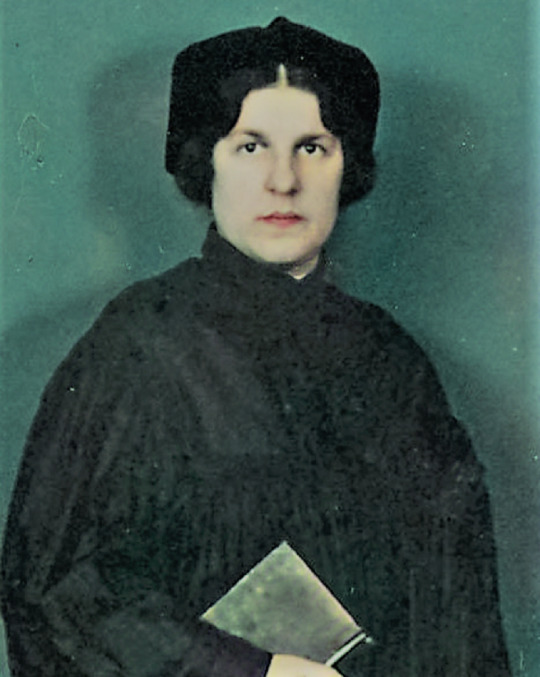
View On WordPress
#Auschwitz#Auschwitz-Birkenau#Berlin#Female Rabbi#Feminism#Germany#History#Holocaust#Poland#Theresienstadt concentration camp#World War 2
1 note
·
View note
Text
Goldie Finkelstein was just 13 when she was sent to Wiener Graben, a work camp that later became a concentration camp. The youngster lost her entire family in the war, and among the things she never learned from them was how to cook. She had no family recipes and, according to her son, when she married Sol Finkelstein, also a Holocaust survivor, she didn’t know how to boil water or cook an egg.
Eventually, other survivors taught Goldie the necessary skills, and she was a quick learner. She soon became known for the copious amounts of baked goods she would provide for any occasion. Her recipes, some of which are included in the “Honey Cake and Latkes: Recipes from the Old World by the Auschwitz-Birkenau Survivors” cookbook, include cake mixes and other ingredients that wouldn’t have been used in pre-Holocaust Eastern Europe. Her whiskey cake, for example, calls for both yellow cake mix and vanilla pudding mix.
Goldie’s experience illustrates the ways in which recipes, including those we think of as quintessentially Ashkenazi Jewish, have changed over the years. Survivors lost the ancestors who passed along oral recipes. Families’ personal artifacts, such as handwritten recipes, were abandoned when Jews were forced to flee.
Most significantly, perhaps, after the war, survivors had access to different ingredients in their new homes. Sometimes that was due to seasonality, such as was the case for those who moved from Eastern Europe to Israel and had access to more fruits and vegetables year-round, including dates and pomegranates. Other times, it reflected changing tastes or newfound wealth — liver soup, pates with liver and offal were classic Eastern European dishes in the early 1900s, when there was an intention to use every part of the animal, but became increasingly uncommon. In other cases, like Goldie’s, packaged goods replaced homemade. Another survivor whose recipes appear in “Honey Cake and Latkes,”Lea Roth, detailed making noodles for Passover from the starch leftover at the bottom of a bowl after grating potatoes before the war. After the war, most people added “noodles” to the grocery list.
“Some of these recipes changed because of New World versus Old World,” explains Jeffrey Yoskowitz, author of “The Gefilte Manifesto: New Recipes for Old World Jewish Foods.” Yoskowitz and his co-author Liz Alpern work not to replicate pre-war Ashkenazi Jewish recipes, but to reclaim and modernize them. To do that, they’ve had to examine the ways in which recipes have changed.
In the Old World, for instance, almost every recipe called for breadcrumbs. At Passover, the leftover crumbs from the matzah were used to make matzah balls, leaving nothing to waste. But when immigrants in the U.S. could use Manischewitz pre-made matzah meal, then recipes started calling for it to make matzah balls.Today’s recipes for kugels with cream cheese, cottage cheese and sour cream would not have been made in the Old World, where dairy products were expensive. Again, ubiquitous cows in the New World made that “celebration of dairy” possible, Yoskowitz says.
At first, recipes may not seem like the most essential thing to recover from Holocaust survivors, but they paint a picture of what life was like before the war. It is essential to see the Jewish experience as one that is not solely as victims, and learning what people ate and cooked is part of that.
“Bringing back recipes can help bring people back to life,” says Edna Friedberg, a historian and senior curator with the U.S. Holocaust Memorial Museum. “In particular, it was women who were in the kitchen in this period, and so this is a way to make the lives of women very vivid and real for people.”
The idea is not to romanticize Eastern Europe, says Maria Zalewska, executive director of the Auschwitz-Birkenau Memorial Foundation, which published “Honey Cake and Latkes,” but to see the memories connected to togetherness, like picking fruit toward the end of the summer and using that fruit in a recipe, such as cold cherry soup with egg-white dumplings.
In addition, examining recipes gives us a sense of what role cooking and food played in trauma processing, Zalewska says. “Remembering the foods and the food traditions of their lives before imprisonment were some of the ways that survivors coped with starvation,” Zalewska adds. These are things that survivors say they are not often asked about, but when asked they report remembering dreaming about food during incarceration.
“We have quite a number of testimonies, where survivors talk about being in situations of starvation, and food deprivation and ghettos and camps and in hiding, and that dreaming about and remembering food from before gave them emotional sustenance,” explains Friedberg.
Exploring such memories have been meaningful for those survivors who were young when they lost their families.
New Orleans’ Chef Alon Shaya has been working for several years to recreate recipes from a book belonging to the family of Steven Fenves, a survivor and a volunteer for the museum. The book was rescued by the family cook, Maris, when the family was forced to flee their home on the Yugoslavia-Hungary border in 1944. The recipes are largely written without measurements, times or temperatures, and many of the ingredients are different from those used today. (Like the Fenves family, Goldie’s son, Joseph Finkelstein, says his mother wasn’t big on using measurements as we think of them in recipes today. She knew the quantity of an ingredient, for example, if it would fit in her palm.) Unlike Yoskowitz, who is looking to update recipes, Shaya has been working to replicate them as closely as possible — and has come across a few surprises.
Many of the desserts use a lot of walnuts, for example, which, of course, are also used in contemporary baking. But Shaya is using what he says are “copious amounts of walnuts” in various ways, such as grilled walnuts and toasted walnuts. The Fenves family walnut cream cake, which includes both walnuts ground in the batter and in a cream in-between the cake layers, has featured on the menu at one of Shaya’s restaurants, Safta, in Denver.
For all the recreation, and Shaya’s goal to bring the tastes of his youth back to Fenves, he says “it is impossible that a recipe in New Orleans would be the same as one in Bulgaria. The seasons are different, what animals are butchered are different, and the spices taste different.”
Indeed, place matters, Yoskowitz says. Ashkenazi food has a reputation of being terrible, he says. Take mushroom soup, for example. “There is no good mushroom soup in a deli. It is made with mushrooms that don’t have much flavor. But if you have it somewhere made with mushrooms grown in the forest, then that is going to be good soup.”
Many Holocaust survivors settled in new lands with new ingredients, and little memory of how things were made before the war. They knew they used to eat mushroom soup but didn’t specifically remember the forest-grown and harvested fungi. So, dishes morphed depending on what survivors had in their new home. In Eastern Europe, veal was plentiful, but in the U.S. and Israel, schnitzel began being made with chicken instead (a process Yoskowitz calls the “chickentization” of cuisine). And the beloved Jewish pastrami on rye? The pastrami would have traditionally been made with kosher goose or lamb. It wasn’t until Jews came to the U.S. that beef was easily accessible.
The same is true of what is likely the most iconic Jewish American dish. “Bagel and lox are what we think of as the most Jewish food. But the only thing that came over was the cured and smoked fish,” Yoskowitz says. “Cream cheese was a New York state invention. Capers were Italians. It was a completely new creation, and it became a taste associated with Jewish people.”
One of the most poignant recipes in the “Honey Cake and Latkes” book is a chocolate sandwich, a basic concoction of black bread, butter and shaved dark chocolate. Survivor Eugene Ginter remembers his mother making it for him in Germany after the war, to fatten him up after years of starvation.
Adds Shaya: “We have to continue to adapt, and I think that that is part of the beauty of it.”
1K notes
·
View notes
Text
ottla kafka (1892-1943)


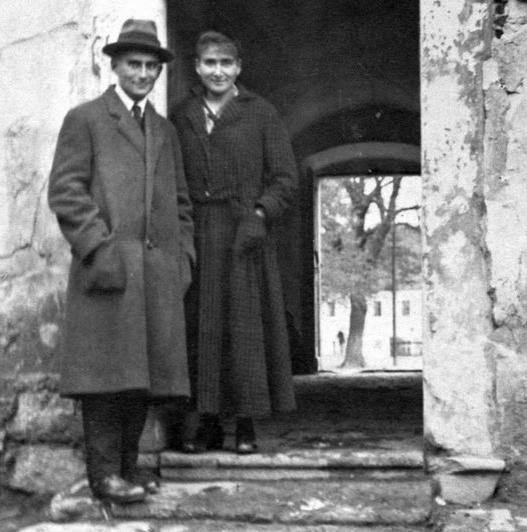


ottilie, nicknamed ottla, was one of franz kafka's three sisters and was closest to him in the family.
to put it in his words: "ottla literally carries me on her wings through this difficult world".

after her school education, she lived and worked on the agricultural estate in zürau, bohemia, over which she also took management. her father, hermann kafka, called this the "zürau escapade". (like her brother, she also had a permanent conflict with her father.)
ottla also temporarily housed her brother franz there, so that he could write in peace and recover from his illness.
on july 15th, 1920, against her father's will, she married the catholic czech josef david and took his last name (= ottla davidová). in the following years, ottla gave birth to their two daughters: věra (1921) and helene (1923).

nevertheless, the marriage was unhappy and she divorced in 1942, which meant that ottla lost her protection from the persecution of jewish people.
ottla was soon deported to the concentration-camp in terezín, where she worked as a caregiver in an infant home.
in early october 1943, she accompanied a transport of children to auschwitz-birkenau. immediately after their arrival, on october 7th, ottla was murdered at the age of 51.
a memorial-plaque at the kafka's family grave commemorates ottla and her sisters, who were also killed in concentration-camps.

457 notes
·
View notes
Text
by Debbie Weiss
Anti-Israel protesters on Monday disrupted an event at Auschwitz, the infamous Nazi concentration camp in Poland, commemorating the six million Jews killed in the Holocaust by the Nazis.
The International March of the Living, an annual Holocaust education program founded in 1988, brings people from around the world to Poland each year for Israel’s Holocaust Remembrance Day — known as Yom HaShoah — to march on the path leading from Auschwitz I to Auschwitz II-Birkenau, the Nazis’ largest death camp where 1 million Jews were murdered during World War II.
Survivors of the Hamas terror group’s Oct. 7 massacre across southern Israel joined 55 Holocaust survivors in this year’s march. However, amid the ongoing Israel-Hamas war in Gaza and the coinciding record surge in global antisemitism, anti-Israel protesters gathered near the grounds of Auschwitz, sparking outrage.
Local police put up a barricade to prevent dozens of demonstrators from approaching the marchers, who passed by as the protesters shouted slogans including “stop the genocide.”

Anti-Israel protesters hold flags on the route of the annual International March of the Living, outside former Auschwitz Nazi German death camp, in Oswiecim, Poland, May 6, 2024. Photo: REUTERS/Kuba Stezycki
Marchers, many of whom carried Israeli flags, responded by changing, “Free Gaza from Hamas!” and singing “Am Yisrael Chai.”
150 notes
·
View notes
Text

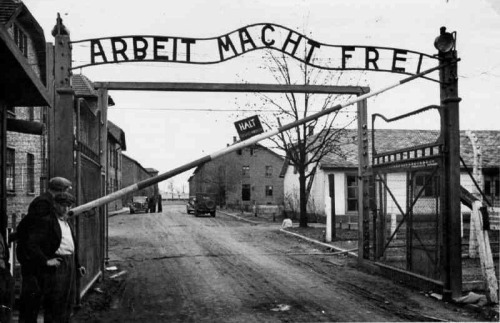
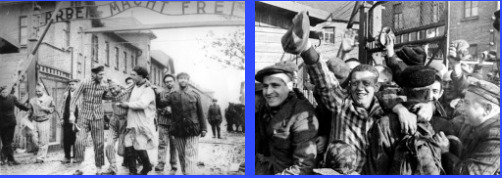

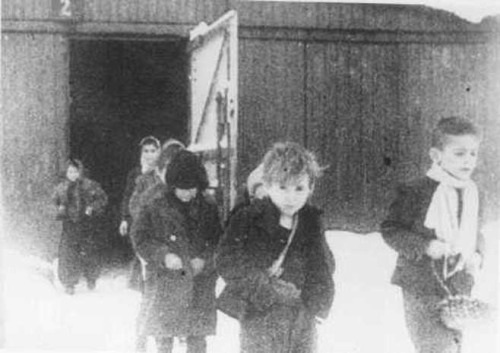
Today is International Holocaust Remembrance Day.
January 27 marks the 79th anniversary of the liberation of Auschwitz-Birkenau, the largest Nazi death camp.
In 2005, the United Nations General Assembly designated this day as International Holocaust Remembrance Day (IHRD), an annual day of commemoration to honor the victims of the Nazi era.
From 1940 to 1945, more than 1.1 million men, women and children were killed in the Auschwitz concentration camp. 90% of them were Jews. All were innocent. Today, we remember
Never Again.
65 notes
·
View notes
Text

Who knew that the Nazis persecuted the Polish Catholic Church because of antisemitism?
Rudolf Rosner was one of approximately 3000 Polish Catholic priests who were murdered by the Germans during the Second World War. Obviously this had nothing to do with antisemitism and everything to do with Nazi Germany's stated goal of destroying the Polish nation.
Long before signing the Molotov-Ribbentrop pact and agreeing to carve up Poland with their Soviet allies, the Germans had already formulated a plan (Generalplan Ost) to turn all of Eastern Europe into the Lebensraum (living space) of Greater Germany. This plan explicitly required the complete destruction of Poland.
Prior to the outbreak of World War 2, thousands of Polish citizens of the Third Reich were arrested and killed. The Nazis also prepared a special list of 61000 of Poland's leading citizens who were to be eliminated following the German invasion (the so-called Intelligenzaktion). They had even drawn up detailed architectural plans to recreate Warsaw as a provincial German town (with a small Polish slave colony in the eastern Praga district).
In his Obersalzberg speech to Wehrmacht commanders on 22nd August 1939, Adolf Hitler explicitly announced that:
…."I have issued the command – and I'll have anybody who utters but one word of criticism executed by a firing squad – that our war aim does not consist in reaching certain lines, but in the physical destruction of the enemy. Accordingly, I have placed my death-head formation in readiness – for the present only in the east – with orders to send to death mercilessly and without compassion, men, women and children of Polish derivation and language. Only thus shall we gain the living space we need"….
Nazi Germany's genocidal intentions towards the Polish people were crystal clear, and although Western historiography on the subject of Poland in the Second World War is focused almost entirely on the holocaust, the Germans also committed some of the worst atrocities in all of human history against the Polish slavic population (mass murder, the destruction of hundreds of Polish villages, ethnic cleansing, deportation of millions of people to concentration and labour camps, the kidnapping of Polish children for forced Germanisation, the brutal suppression of the Warsaw Uprising etc).
They systematically persecuted the Polish Catholic Church as part of the Nazi campaign of cultural genocide in Poland. Thousands of churches and monasteries were closed, seized or destroyed, and eighty percent of Polish Catholic clergy were sent to German concentration camps, where at least 1800 lost their lives (more than 800 in Dachau alone).
The Auschwitz concentration camp was established on Heinrich Himmler's orders in April 1940 and was located in Polish territory that was incorporated directly into the Third Reich. Alongside Stutthof (opened in 1939) and Majdanek (opened in 1941), it was constructed initially to intern Polish slavic prisoners.
The Germans incarcerated approximately 450 priests, seminarians and monks in Auschwitz, as well as 35 nuns. Most of them perished there or in other German camps.
#auschwitz#auschwitz-birkenau#concentration camp#german concentration camp#history#second world war#world war 2#germany#poland#polska#bad history takes#bad history take
3 notes
·
View notes